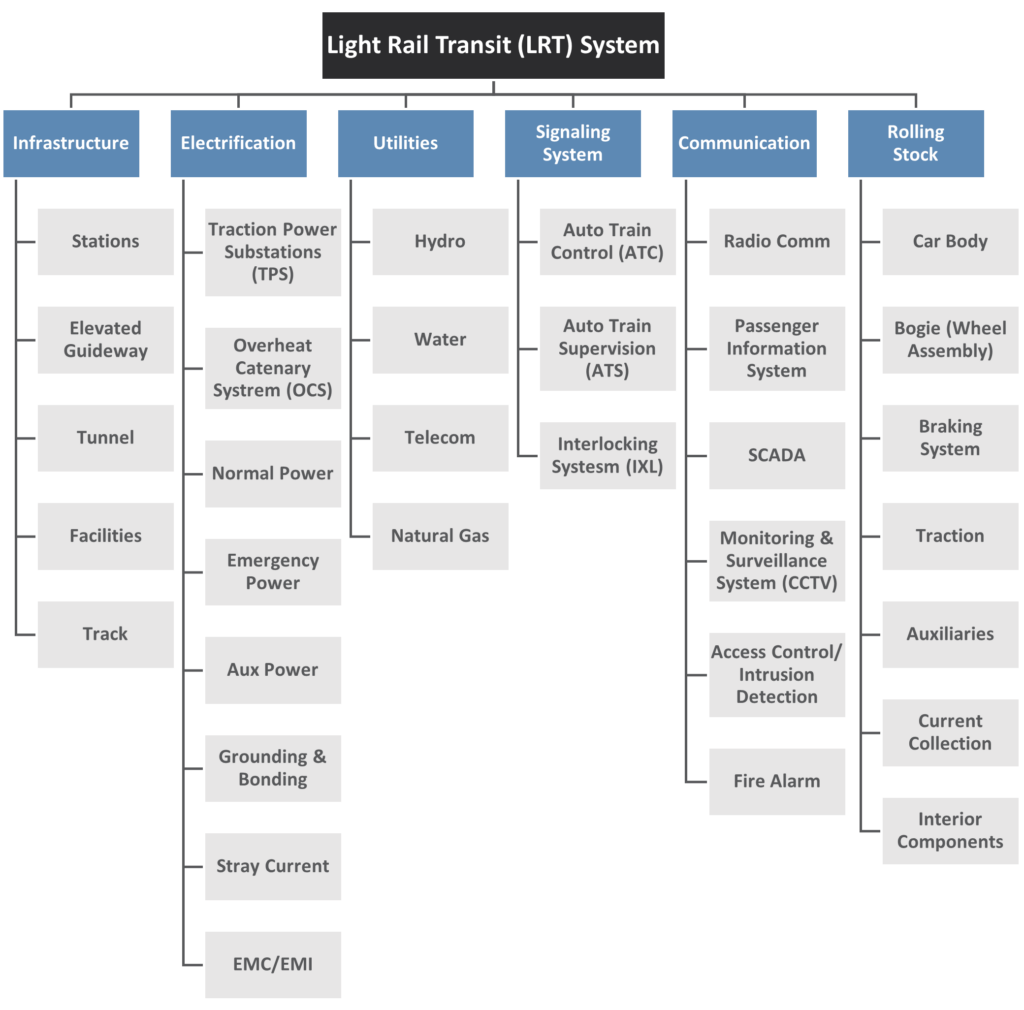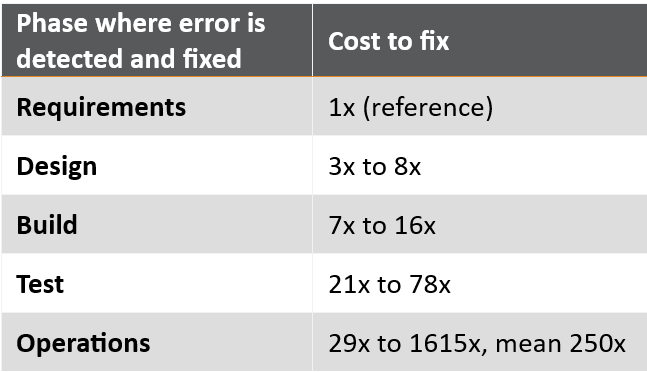By Hany Soloumah, Ph.D, P.Eng., PMP, CPEM, ASEP, Director Traction Power Systems | EXP
Systems engineering (SE) is a structured and auditable approach to transforming a set of stakeholder needs, expectations and constraints into a solution. This is achieved through the process of identifying requirements, managing interfaces and controlling risks throughout the project lifecycle.
The main goal of all SE activities is to manage risk, including the risk of not delivering what the client wants and needs, the risk of late delivery, the risk of excess cost and the risk of negative unintended consequences.

Figure 1: Generic System Lifecycle
Adhering to the systems engineering processes ensures that both the system developer and stakeholders can be confident that “the system is built correctly,” meaning it is constructed according to the design and specifications. Moreover, that the system meets stakeholders’ needs and requirements, and performs as required in its operating environment.
Systems engineering accomplishes these goals by considering the whole problem, through the whole system lifecycle from concept to retirement.
All infrastructure and transportation mega projects are characterized by large investments of dollars and time. These projects span years to produce complex systems with expected utilization lifecycles of several decades. A few clear trends in recent mega transportation and infrastructure projects are increased complexity, additional financial scrutiny and a requirement to be developed under a tight delivery schedule. These factors can cause projects to encounter challenges or failure to deliver on time, within scope or within budget.
Systems engineering should be utilized during the project lifecycle. SE, when utilized early during the project lifecycle, helps mitigate financial, technical and schedule risks, and reduces the element of surprise during integration, verification and validation and putting into service. SE becomes even more crucial when implementing systems that must pass and obtain safety certification before it can put into service such as rail, aviation and healthcare systems.
Figure 2: The light rail transit system shown below highlights the importance of SE.

As a system developer, you might be faced with multiple and sometimes conflicting views regarding SE.1
On one side, SE Efforts are crucial because they:
- Have a high return on investment.
- Ensure stakeholders’ requirements are identified and addressed.
- Provide a proactive way to manage risk.
- Establish the foundation for all aspects of the design.
- Optimize the design through evaluation of alternative solutions.
- Identifies the interfaces early in the design process and makes integration run smoothly.
Conversely, SE efforts should be minimized because:
- Including SE costs, a project bid will make it non-competitive.
- Concern about “paralysis by analysis” and desire to get the design started.
- Lack of budget or the people to support SE efforts.
- SE doesn’t produce deliverable outputs.
- Clients won’t pay for SE efforts.
It is important to balance the SE effort and tailor SE processes. This approach enables adaptation to the project and systems to optimize ROI by minimizing financial, technical and schedule risks.
According to SE principles, “Complex systems are engineered by complex organizations.”1
Complex organizations have the appropriate amount of processes as well as the technical understanding to unfold the complex system, work on its elements and gain insights with right amount of management and control to develop such systems through its life cycle.
SE provides a holistic framework for organizations to navigate complex systems.
Infrastructure and Transportation Projects and SE
Infrastructure and transportation projects involve complex design activities. From roads and bridges to railways, airports and even autonomous vehicles, these systems require extensive and detailed planning, design and coordination.
Managing the documentation and incorporation of a multitude of requirements, preparing a design to meet those requirements, integrating the components of the design and verifying and validating that the design has met requirements are all facilitated by the application of systems engineering principles.2
Design efforts can suffer several challenges due to inadequate application of systems engineering methods. For example, if the requirements are not properly documented and managed, the design may not include elements critical to meeting the needs of stakeholders or applicable codes or standards. Often, the various components of the design are not well integrated, leading to design conflicts. Changes in requirements or stakeholder needs lead to scope creep, late design changes and cost and schedule overruns. Solving these and other issues drives the need for a more formal approach to managing engineering design on infrastructure projects. Systems engineering helps address these issues in an increasingly complex environment.2
Realizing the several benefits of the application of systems engineering methodologies in infrastructure and transportation projects, several government agencies have developed programs to implement such procedures, such as the United States Department of Transportation and Australia’s Transport for NSW.
Benefits of systems engineering
Similar to the benefits the organization realizes when implementing quality management system (QMS) or project management (PM) processes, systems engineering has many benefits including:
- Avoid pitfalls due to missing information and incorrect assumptions.
- Managing real-world changing issues.
- Producing the most efficient, economical and robust solutions to the need being addressed.
By using the SE approach, project costs and timescales are managed and controlled more effectively.
Systems engineering provides greater control and awareness of the project requirements, interfaces and issues and the consequences associated with any changes.
Due to the holistic approach of SE that starts at the concept stage of the system, SE practitioners can detect and fix errors early on in the project. The cost of fixing problems in a project depends on when the error was detected.
According to research completed in the “Error Cost Escalation Through the Project Life Cycle,”3
- If it costs $1 to fix an error that you discover in the requirements stage, it will cost $250 if you discover it in operation.
- The larger or more complex the project is, the higher the cost to fix, and the higher the risk.
- It costs much less to solve problems early on, rather than later in the project lifecycle.

How much SE is needed for project success?
A 2013 study was completed at the University of South Australia to quantify the return on investment (ROI) of SE activities on overall project cost and schedule. Study data show that SE effort had a significant, quantifiable effect on project success, with correlation factors as high as 80%.4 Results show that the optimum level of SE effort for a normalized range of 10% to 14% of the total project cost.
The ROI of adding additional SE activities to a project varies depending on the level of SE activities already in place. If the project is not using SE activities, then adding SE carries a 7:1 ROI; for each cost unit of additional SE, the project’s total cost will be reduced by seven units. At the median level of the projects interviewed, additional SE effort carries a 3.5:1 ROI.
Steps to successful system/project realization
SE provides a complete set of processes that organizations can adopt to ensure the successful realization of a complex project. These processes must be tailored to the organization and project specifics. From these processes, the following three forms are crucial for a successful start to implementing SE.

Agree and manage requirements
Requirements form the basis for contracts and acceptance. Starting from the desired effect of the new system, balance requirements with budget and technical feasibility. Identify and consult relevant stakeholders. Identify and manage assumptions. Assess the impact of proposed changes and trade-offs and test the system against its requirements.
Agree and manage interfaces
Manage interfaces to make sure the parts of the solution combine and the operational environment to create an effective whole – and to allow teams to work in parallel, confident that all the pieces they are developing will fit together and work together. Identify who is responsible for and involved in each interface.
Track progress against a plan
As well as the traditional project management measures of cost, schedule and resources, it is important to track skills, decisions and technical performance. Adapt to changes and be prepared to backtrack on decisions. Failure to agree on requirements or interfaces may be symptoms of deeper problems.
Requirements management
Large infrastructure and transportation projects are subject to the requirements of a multitude of stakeholders. Requirements originate from the contract, laws and regulations, operational concepts, site conditions, external interfaces and utilities, industrial codes and standards, operator needs, the public interest and other sources.
Projects often encounter several types of problems caused by inadequately managed requirements. For example, contractual and regulatory commitments may be overlooked, requirements do not flow down to subcontractors or suppliers or requirements are incomplete, unclear, not regularly updated, and subject to widely varying interpretations. Projects have difficulty demonstrating requirements were met and the responsibility for managing the requirements is often unclear. Solving these and other issues drives the need for a more formal approach to managing requirements.
Requirements management (RM) is the process of gathering, documenting and validating requirements and managing their implementation and change. It is a process that runs continuously throughout the project life cycle and relates to other project management processes, such as quality and change management.
One of the most important tasks in RM is requirements allocation. This is accomplished by careful review of the requirements in their entirety and allocating each requirement to the appropriate sub-system. Requirements shall flow down from the system level to the sub-system level down to the system element level.
Interface management
Interface management facilitates and manages the identification, definition and design of the interfaces of the system as well as interactions across these interfaces. It is critical for the project team to identify and define each of the interactions between all system elements that make up the integrated system as well as interactions of the integrated system with external systems and users. Failing to do so will result in costly and time-consuming rework during system integration, system verification and system validation.
Interface management helps highlight underlying critical issues much earlier in the project than would otherwise be revealed that could impact the project’s budget, schedule, and system performance. Identifying these interfaces early in the project allows for proactive management of these interfaces as well as developing the integration plan.
Assessment and control
Project assessment collects data to evaluate the adequacy of the project infrastructure, the availability of necessary resources and compliance with project performance measures. Assessments also monitor the technical progress of the project and may identify new risks or areas that require additional investigation.
Project control involves both preventive and corrective actions taken to ensure that the project is performing according to plans and schedules and within projected budgets.
A useful tool is a project dashboard that provides a timely and easy summary of status. It is important that status should be concise and visual (usage of red/yellow/green traffic lights) to quickly and easily identify the critical issues on which urgent actions for recovery are required.
To learn more about Systems Engineering for your next mega project, contact Director Traction Power Systems Hany Soloumah.
Learn more about Infrastructure and Rail and Transit at EXP.
References
- Davies, P., Thales, & INCOSE UK. (2013). Quantification of the Value of Systems Engineering. INCOSE UK. ac.uk/media-library/sites/eng-systems-centre.
- Applying systems engineering to industrial & infrastructure projects. (n.d.). INCOSE INFRASTRUCTURE WORKING GROUP. org/docs.
- Haskins, Bill & Stecklein, Jonette & Dick, Brandon & Moroney, Gregory & Lovell, Randy & Dabney, James. (2004). 8.4.2 Error Cost Escalation Through the Project Life Cycle. INCOSE International Symposium. 14. 1723-1737. 10.1002/j.2334-5837.2004.tb00608.x. net/publication/285403716_842.
- Honour, E., University of South Australia, & Honourcode, Inc. (2010). Systems Engineering Return on Investment. INCOSE. mst.edu/lib-circ/.
- Systems Engineering Handbook, 5th Edition. (n.d.). Wiley.com. com/en-us/INCOSE+Systems+Engineering+Handbook.

